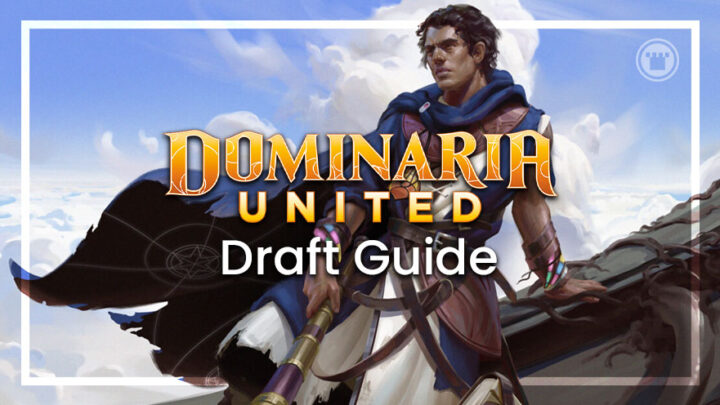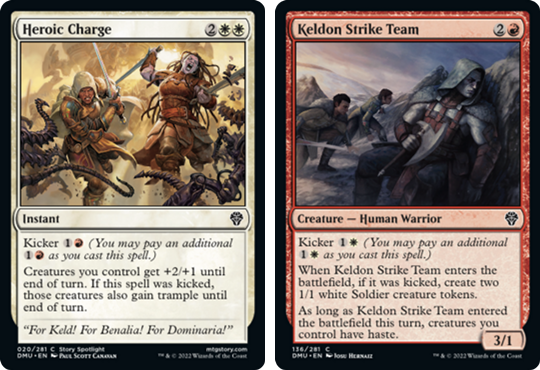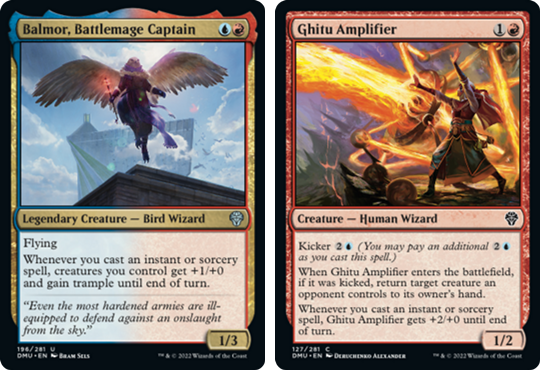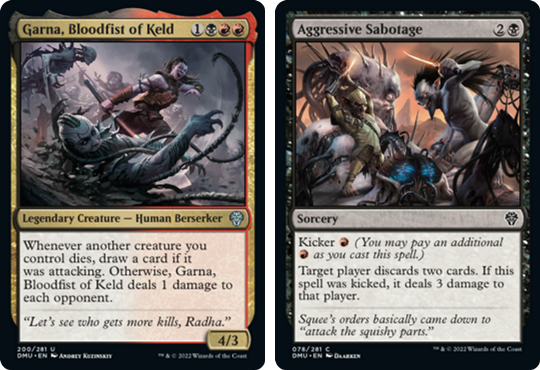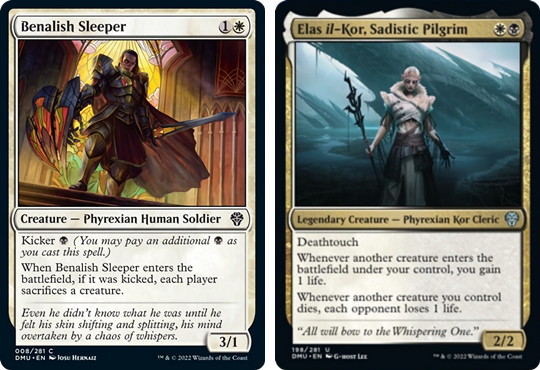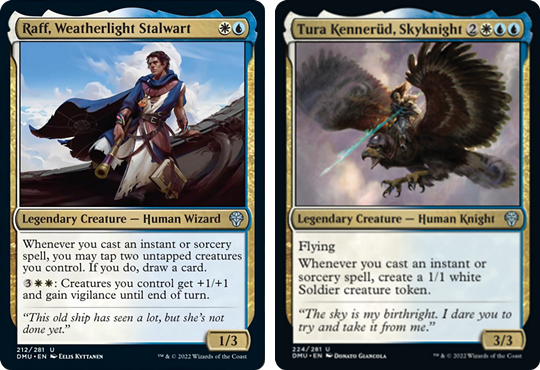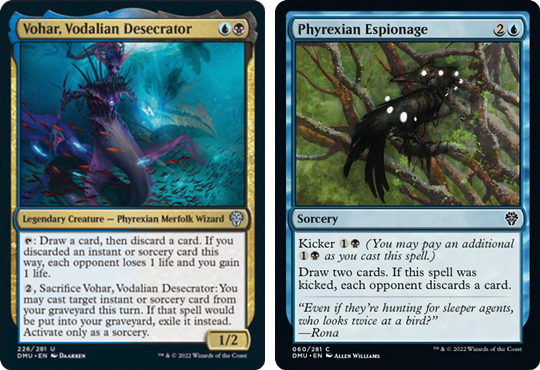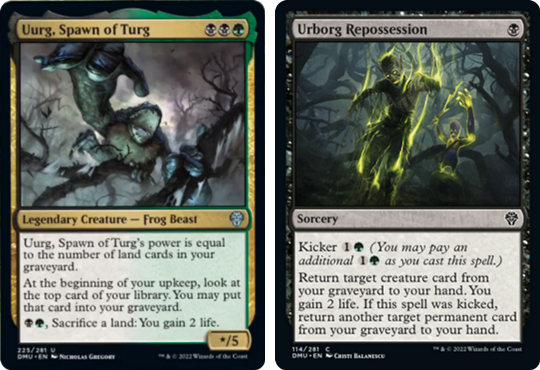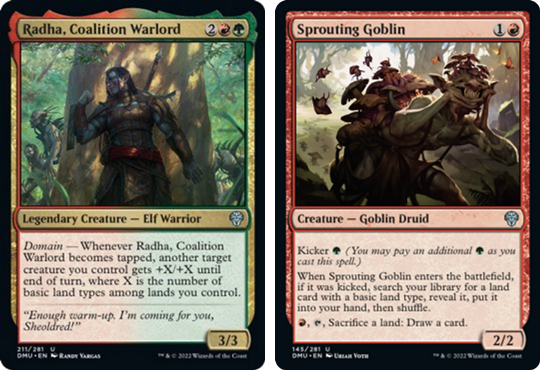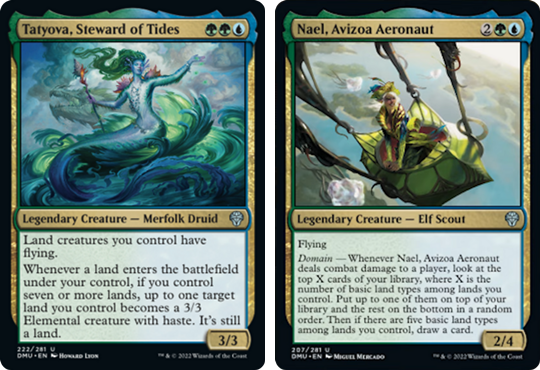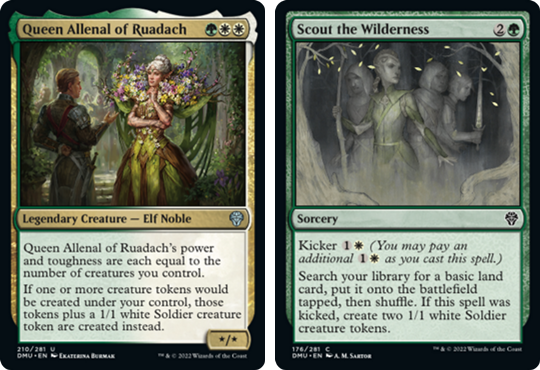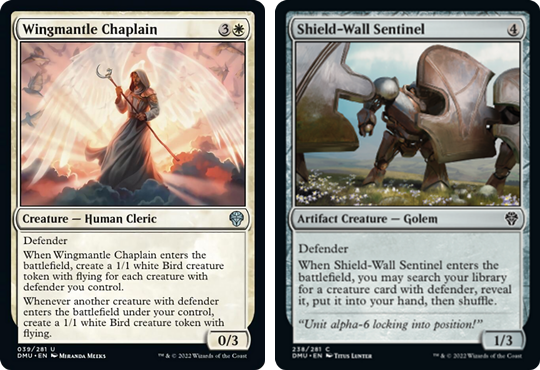As a plane, Dominaria’s mechanical identity is roughly “Magic the way Richard Garfield intended” — and Dominaria United returns to the core gameplay values people praised in the last Dominaria draft format.
Matches are slower on average than in Streets of New Capenna or even Kamigawa: Neon Dynasty. A lot of cards lock their power behind kicker costs or activated abilities, making it difficult to cast multiple spells a turn, even at five or six mana.
Most decks are incentivised to play a bunch of enter-the-battlefield tapped dual lands, regardless of archetypes. And for one of the few times I can remember in recent history, stat distributions favor early blocking.
In the past, sets like these tend toward board stalls and over-complicated messy game states. But steps have been taken to prevent this in Dominaria United. It’s very hard to draw multiple cards at a time, which naturally slows down development after the initial curve. The number of cards which offer in-built recursion from the graveyard is vanishingly low, too.
Strong common removal in every color does extend the game, but it keeps boards small as you trade off your already-reduced supply of cards. So, rather than a see-sawing momentum battle between ever-expanding armies, Dominaria United feels like a mutual siege. You win by sallying out with calculated, concentrated force — or by establishing better supply lines.
It’s a noticeable change of pace for Limited, and even if the slowest games might test your patience, I’ve found it to be a worthwhile one so far.
DEALING WITH DOMAIN
With Phyrexian horrors once again afoot in Dominaria, DMU sees the triumphant return of the Domain mechanic. This isn’t just an incidental keyword. This is a format-defining theme akin to Snow — even including the extra wrinkle of prioritizing land picks.
These basic-land-typed ETB-tapped duals are obviously powerful and can be worth a slot even when only one of the colors aligns with your deck. In addition to powering up domain spells, they can help you splash an off-color rare or pay a value-added kicker cost on cards you were already playing.
In drafting terms, their presence incentivizes you to be more focused and commit sooner to a particular color “lane.” The need to spend picks on lands, even early in a pack, means fewer picks to speculate on cards you end up not playing.
With that said, not every deck is going to be focused on the Domain mechanic, especially to the point of including all five land types. The incentives for that are mostly for green-based decks, and I would still say 80% of those end up as three-color decks that sneak in an off-color dual or two rather than true five-color good stuff. For other archetypes, two colors with a sneaky splash card is usually the way to go.
Even with these excellent lands, there’s just not enough fixing around to support rainbow drafting. If anything, the mana-intensive nature of the format makes it very punishing to be color-screwed in the early game: it’s hard to catch up when you can’t double-spell (or even single-spell!) because you need to keep activating last turn’s creature to trade well.
COLOR & ARCHETYPE BREAKDOWNS
This is another area where Dominaria United has been giving some “core set vibes” — the color-pair archetypes are extremely loose-knit, with only incidental synergies compared to tribal sets or those with enabler-payoff mechanics, like Ninjutsu.
For the most part, you’re just trying to find the colors in your draft which offer strong rares and removal, and then playing whatever other spells you can cast off those lands. However, it’s still worth considering the relative strong points of each color pair and how you should picture those decks looking:
RW: Go Wide Aggro
Yes, we’re back to ol’ reliable for RW draft gameplay, although there are a few quirks to be had. There’s a bit more token generation than you might expect, which raises the expected value of Heroic Charge as a finisher. You also get some respectable burst damage from hasty creatures and burn — Lightning Strike is back in town!
The Enlist mechanic is more marginal than it first appears, but it can be used to trade your cheaper creatures up into large blockers instead of “chump attacking.” Don’t bite on any perceived equipment/aura subtheme — unfortunately, all those cards have atrocious win rates. Just stick to creatures, removal and tricks.
UR: Spellslinger Tempo
Another well-worn, Limited archetype here. Although, for my money, this version of the deck is as difficult to pilot as it’s ever been. Aside from Essence Scatter, the blue tempo spells seem a little more expensive or clunky than one might expect — and competition for Lightning Strike and Flowstone Infusion is fierce. Flyers are somewhat scarce and the closest equivalents to Frost Lynx or Man-o’-War are five mana each.
You do have decent cantrips in Anticipate, Timely Interference and Thrill of Possibility, which help consistently trigger Balmor, Battlemage Captain, Haunting Figment and Ghitu Amplifier — assuming you can draft enough of them. You can also fall back on the excellent Shore Up as protection for a larger threat like Tolarian Terror or Djinn of the Fountain to force through your lethal damage.
RB: “Trade Happy” Aggro
One could argue that this is also a tempo deck, but to avoid confusion with UR, let’s just say that RB wants both players to empty their hands (and boards) ASAP. Your creatures’ stats trade with most blockers and you have the best removal in a removal-heavy set. This includes Battle-Rage Blessing, which can easily become a tempo-positive two-for-one when combined with your numerous menace creatures.
With the board kept small, those menace creatures let you sneak around a single, large blocker to keep forcing the race — which you can then win a turn ahead of schedule with a final blast of direct damage from Lightning Strike, Aggressive Sabotage or Meria’s Outrider. Black can also fill those slots with strong recursion, but your strength is in spending so-so cards dearly and winning fast, so aim for that.
WB: War of Attrition
This is one of the least-coherent color pairs in DMU Limited. That is not to say it isn’t strong — just that the game plan of a given WB deck tends to vary based on which rares or subtheme you latched onto in the draft. You might have a slow, removal-heavy build relying on a few key bombs and the ability to recur them. Or, you might play fast and wide to whittle down an opponent’s life, getting them low enough to drain the rest.
WB has the best access to this set’s rather limited number of sac outlets; in particular Gibbering Barricade, Benalish Sleeper and Bone Splinters. These obviously play well with cards like Cult Conscript or Captain’s Call, but also with the wall subtheme and Wingmantle Chaplain — if you can get it. Try a few different approaches and feel out which you prefer to shoot for with these colors.
UW: Board-Based Control
The UW decks seem to be very popular (at least, I’ve had trouble getting my hands on them in my own drafts), and it’s not hard to see why. They have arguably the two most synergistic gold uncommons to play around, as well as a wide range of cantripping instants and sorceries. While it can become tricky to balance the right mix of creatures and instants/sorceries (especially when your two common removal spells are enchantments), it only takes a little bit of bonus value to get over the top in a format so stingy on card draw.
Playing the slow game, as you tend to do, there’s also plenty of room here to splash outside of UW. It’s worth making the effort to draft any dual lands that can tap for at least one of your main colors, since at bare minimum it upgrades Artillery Blast into bargain removal.
However, you’d mainly like to add a third color for the extra late game power it allows. Tatyova, Steward of Tides is a particular standout where no bonus rares are available.
UB: Spell-Based Control
This is the kind of deck most people probably imagine when you say “control” — concentrating what little true card advantage exists in DMU alongside a ton of efficient removal, walls and flyers. Like UW, you need to adjust to your spells being sorcery speed, expensive or both. But once you do this, all feels very straightforward — especially in the draft phase. Just take the kinds of cards that are always good.
Phyrexian Espionage is a great example, being a particularly strong Divination in a set where Divination itself would already stand out. Shadow Prophecy gives you an instant speed option, which still puts you up a card, especially if you can bump your domain count with some random dual lands.
I actually like going into a full Sultai deck where I can get it, as this unlocks powerful kicker spells like Urborg Repossession, Tear Asunder and Choking Miasma. Vineshaper Prodigy and Floriferous Vinewall also provide efficient fuel for black’s sac outlets.
GB: Graveyard Midrange
GB is usually one of the first decks I warm up to in a new Limited format. There’s something safe and reliable about the combination of big bodies and unconditional removal which makes it hard to go wrong. That’s more true than ever in this set, where stumbling is heavily punished and synergy between cards is a less obvious factor. Just playing individually strong spells — often several times a game — is all it takes to get GB over the line.
The recursion here is extremely good, focusing on efficiently returning cards to hand through Urborg Repossession and Eerie Soultender. I know I’ve mentioned Cult Conscript a few times already, but that’s because it’s among the stronger Reassembling Skeleton type cards we’ve seen in a hot minute. The few self-mill effects in the set also punch above their weight, and Jodah’s Codex is usually available if you need card quantity to supplement quality.
RG: Domain Stompy
Realistically, any Gx deck in this format is going to exist somewhere along the axis of “five-color domain,” but RG is the pair which most heavily embraces that mechanic. As opposed to the speed-and-interaction game plans favored by other red archetypes, this deck aims to simply be the biggest thing on the board as much as possible, daring opponents to keep up. Domain helps with this by souping up Sunbathing Rootwalla, Nishoba Brawler and Radha, Coalition Warlord — not to mention the impressively efficient Gaea’s Might.
It’s possible to play this as a ramp deck, too, but I prefer to lower the curve instead, paying kicker on the excellent Viashino Branchrider and Yavimaya Iconoclast before burning opponents out with Meria’s Outrider or trampling through with Colossal Growth.
A third option is to overload on big bodies, in particular Yavimaya Sojourner and Molten Monstrosity. The former is easily discounted by playing dual lands while the latter is discounted by playing tricks or enlist creatures.
UG: Domain Ramp
To be honest, there’s not really any pure UG decks in this format — at least, not that I’ve seen in my first 20+ draft runs. This archetype is even more likely to spill into three, four, five colors than the one above, but it is extremely powerful for its diversity and has very nice payoffs. Joint Exploration is two cuts above every other ramp effect, particularly for its instant speed, and Shore Up is at its best protecting huge green creatures (or Tatyova!)
This is 100% the deck where you want to be running off-color dual lands to ensure you maximize Domain. Several of the better ramp cards specify you can search for a card “with a basic land type,” allowing you to consistently rip that Sunlit Marsh out of your deck when you need it. Bortuk Bonerattle is more or less an UG card despite its printed colors, as are Shalai’s Acolyte and Fires of Victory. Play whatever you think can take you over the top in the late game, which often means walls (see below).
GW: Token Midrange
Unfortunately I’ve found this archetype to be a little undercooked, or perhaps the overall defensive slant of the set simply doesn’t favor it. There’s a general lack of both enablers and payoffs for the tokens theme, so WG is a collection of cards that would probably play better in other decks. As an avowed token-deck fanboy, I would strongly advise against aiming for this as a standalone archetype.
However, much like UB, this easily becomes an excellent three-color deck and can work in any of those directions. Naya brings in the missing share of your go-wide aggro payoffs to swarm in early while Bant helps you reach and win the late game with your great chump-blocking capacity. Abzan simply offers excellent removal and a ton of sac outlets for your tokens. Salvaged Manaworker is an A++ option in any of these decks, providing effective mana fixing without slowing down your creature curve.
W/G/U/B: WALLS!
I’ve alluded to it a couple of times in the color pair descriptions, but Dominaria United also contains a special bonus archetype — defender tribal! Shield-Wall Sentinel and Wingmantle Chaplain are an absurdly successful duo in the early stats, but all the various defenders are solid cards and generally make each other stronger while suiting the serene pace of play found in this format.
You can play a few different variants of this deck depending on your colors. Bant and Abzan work well, as do WB and even UB (with or without Chaplain splashed in). You can get into the deck by drafting Wingmantle Chaplain early (which statistically, you should do when you see it) or by speculating on some Sentinels when you don’t have much else exciting to grab. If you get a couple of the latter, it all but ensures you’ll land a big flock of birds, which will usually end the game in a couple of turns.
Blight Pile and Coral Colony can be backup win-cons, although generally I find Gibbering Barricade to be the highlight of the black-having versions. The rest of the deck besides walls pretty much falls in line with what I’ve already said about UG or UB archetypes. Just make sure not to underestimate this deck!
A RETURN TO CORE VALUES
I’ve already seen a general consensus that Dominaria United feels a bit like a Core Set, what with the slower gameplay and fundamental mechanical themes. But with the genuine tension around drafting dual lands and balancing color requirements, plus some extra quirks like the Walls subtheme, I’ve found it to be more interesting and flexible than that might imply.
Hopefully the above pointers can help you orient yourself as we head towards the paper release and the first full week of digital drafting. Next week, I’ll be back with a more detail-oriented and data-driven analysis to break down the finer points of drafting Dominaria United by the numbers!

Tom’s fate was sealed in 7th grade when his friend lent him a pile of commons to play Magic. He quickly picked up Boros and Orzhov decks in Ravnica block and has remained a staunch white magician ever since. A fan of all Constructed formats, he enjoys studying the history of the tournament meta. He specializes in midrange decks, especially Death & Taxes and Martyr Proc. One day, he swears he will win an MCQ with Evershrike. Ask him how at @AWanderingBard, or watch him stream Magic at twitch.tv/TheWanderingBard.

